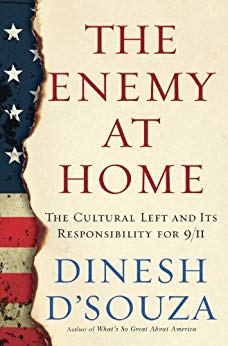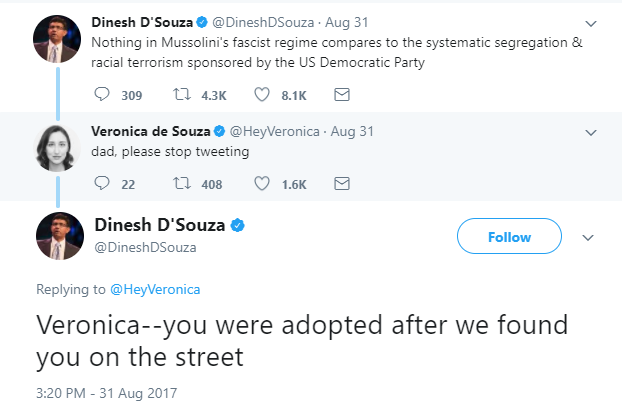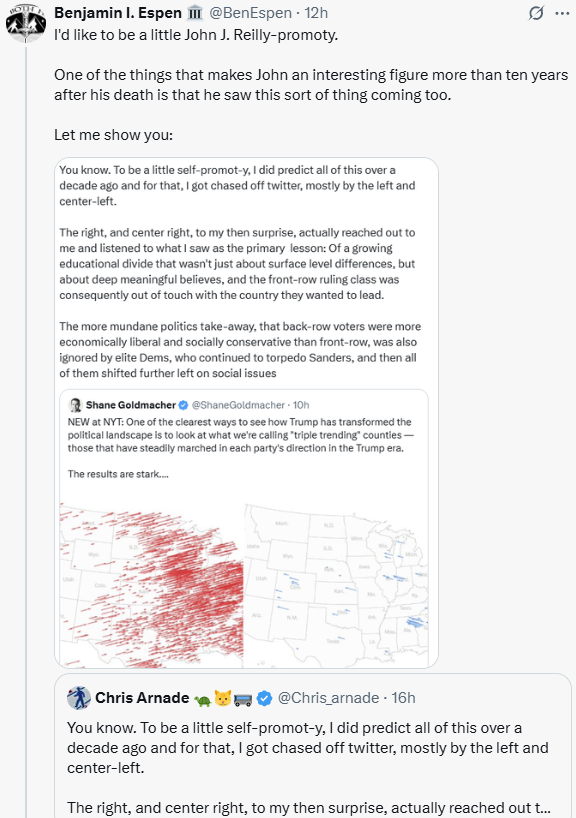The Long View: The Enemy at Home

I’m not sure it was even fair in 2007 to describe Dinesh D’Souza like this:
Dinesh D’Souza, a noted public policy expert now resident at the Hoover Institution
But by now, it is clear that D’Souza is a hack, but at least he maintains a reasonable sense of humor, as the tweet below demonstrates.

Still funny
The Enemy at Home:
The Cultural Left and Its Responsibility for 9/11
By Dinesh D’Souza
Doubleday, 2007
333 Pages, US$26.95
ISBN 978-0-385-51012-7
Dinesh D’Souza, a noted public policy expert now resident at the Hoover Institution, has been regaling his readers for years with tales of the political and cultural depravities of the American left. In The Enemy at Home, he takes this polemic to a more cosmic level. The result is a thorough, thoughtful book that mixes many valid points with others that are, at best, problematical. The author’s critique of the left has a subtext that conservatives might want to think twice about before signing on for his planetary culture war.
“Why do they hate us?” spokesmen for the cultural left asked immediately after the attacks of September 11. Then they pointed their fingers at their allegedly bigoted and militaristic conservative countrymen. D’Souza’s thesis is that the fingers should have been pointed in the opposite direction. The essentially bohemian cultural and family mores of the cultural left have been foisted for two generations onto American society as progressive social policy; more recently, the left has used popular culture and the increasing coercive power of the UN and transnational agencies to impose these policies abroad. The effect has been to incite outrage among traditional peoples worldwide. In the case of Islam, the outrage created a violent radical faction that struck back. This is the state of things today:
“So, realize it or not, American conservatives are fighting a two-front war. The first is a war against Islamic radicalism and fundamentalism. The second is a political struggle against the left and its pernicious political and moral influence in America and around the globe. My conclusion is that the two wars are intimately connected. In fact, we cannot win the first war without also winning the second war.”
The book is very precise in identifying the cultural left. In fact, towards the end, there is a helpful list of the politicians, academics, artists, and organizations who are its most well-known proponents. As a matter of definition, though, the cultural left consists of those people who look to their subjective intuitions for moral standards, rather than to a pre-existing standard outside themselves. The latter is the mark of traditional peoples the world over, including Christians. These traditional moral systems, we are assured, differ only in detail. Cultural leftists do have a morality, but a modern, highly aggressive morality based on personal autonomy. The author never ceases to remind us that cultural leftists love America and wish to spread its ideals universally. The problem is that the America they love is exclusively their own:
“Here in America, a longtime man of the left, Christopher Hitchens, argues that modern America represents the values of secularism, feminism, and homosexuality. An outspoken atheist, Hitchens is the author of a book vilifying Mother Teresa entitled The Missionary Position. It is ‘godless hedonistic America’ and the state of Massachusetts’s recent sanction of practices such as homosexual marriage, Hitchens gleefully points out, that provoke the ‘writhing faces and hoarse yells of the mullahs and the fanatics.’ It is in defense of this godless, hedonistic America that Hitchens supports the Bush administration’s war on radical Islam.”
The author supports that war too, including the war in Iraq, in part because America’s enemy in that war is what he calls “radical Islam.” The latter is a modern deformation of traditional Islam, though these two differ in tactics and political temperament rather than theology. Only through alliance with traditional Islam is there hope for traditional, Red State, Christian America. (Late in the book, traditional Judaism gets a friendly nod, too.) The author contends that though “liberalism” in the Hollywood sense is repulsive to traditional people, classical liberalism is not. Islam, in the author’s telling, is entirely consistent with democracy, market economics, the rule of law, and the decent treatment of women. If America again becomes known in the world as the chief proponent of those things, as well as for respect for religion, the popular base for the radicals will evaporate.
The author is a Catholic from India, a country whose Hindu heritage is quite as traditional as that of Islam. Muslims are tempted to fly airplanes into American skyscrapers but Hindus are not, if I understand the argument correctly, because the Islamic world is governed by “liberal tyrants.” These regimes curry favor with transnational institutions by importing the latest ideas about family law and homosexuality from the West, and particularly from America. By the end of the 1980s, the domestic opposition to the liberal tyrants had despaired of overthrowing them. However, the collapse of the Soviet Union, and then the apparent unwillingness of the Clinton Administration to suffer military casualties, persuaded the radicals that America itself might easily be intimidated into a retreat from the Muslim world, thereby leaving the American client-regimes vulnerable.
Once the attacks began (and remember, they began in 1993 with the first bombing of the World Trade Center), the cultural left has either opposed any forceful American response to them, or has insisted that the response be restricted to futile law enforcement. There are several reasons for this opposition, none of which is connected with pacifism. For one thing, some members of the left immediately imagined that their own critique of American society was also held by its enemies, and so they pronounced the attacks justified. Another reason for opposition, at least according to the author, is that the Bush Administration has sought to spread democracy. The left has soured on democracy as a method of implementing its cultural agenda; it is much happier working through the courts and through transnational institutions. Finally, and most important, the attacks of the radical Islamists may be directed at America in general, but they are not directed at the cultural left in particular. Indeed, Osama bin Laden has increasingly adopted the rhetoric of the antiwar left. American conservatism, in contrast, represents an existential threat to the cultural left. If the Republicans won the war in Iraq, there might be no getting rid of them. Thus, the cultural left is in a de facto alliance with radical Islam against Red State America.
Yikes.
Regarding the author’s most sensational charge, we may note that there is some sentiment among the European left, particularly in France, to nominate Islam as the successor revolutionary ideology to Marxism. That is not quite what he accuses the cultural left in the United States of, which is just as well, since there seems to be little of that sentiment in America. As for the strategic alliance he discerns between radical Islamists and the cultural left, one could see how that might make sense from their point of view. Still, it’s not clear who, if anyone, has actually thought these things. The current antiwar left differs from its Vietnam era counterpart in that it has little to do with revolutionary ambition. Rather, it is founded on incredulity at the proposition that the United States might actually be in danger.
Some of the most provocative elements of the author’s thesis are true. The cultural progressivism that is promoted by transnational organizations really is an annoying hoax, often promoted with the aid of front organizations designed to give a Third World veneer to the latest clap-trap from the American law schools. It is also true than many of the creations of American culture, both high and low, raise doubts not just about their creators’ virtue, but about their sanity. The cultural left really does make America look ridiculous and repulsive abroad. At home, of course, the cultural left is a menace because of the ever-present danger that a majority of the people might accept its transgressive view of the world. A transgressive culture is not worth dying for, or even perhaps worth living for. (We get only a brief mention of the phenomenon of the demographic collapse of culturally liberal societies; maybe that is another book.)
Be that all as it may, the author does the Islamists, and particularly al-Qaeda, too much honor in accepting their own account of their grievances. Osama bin Laden’s statements in particular about the dealings of the United States government with Muslims societies over the past two decades are Big Lie propaganda. The behavior of the Islamist radicals does not suggest desperate defense, but confident ambition. Yes, they think America is vulnerable, but getting rid of America is only a step in a program that includes winning a civil war against the House of Saud. Perhaps the dazzling prospect of Islamic revival blinds them to reality, but they are not acting because they are frightened. A less contemptible America would not necessarily draw less fire.
Readers of The Enemy at Home will note points that are familiar from other writers. The idea that the United States should seek out allies among traditional Muslims is unexceptionable. The point was mentioned, for instance, in Walter Russell Mead’s Power, Terror, Peace, and War (2004). In many ways, though, D’Souza’s more thorough development of this strategy updates the proposal that Peter Kreeft made in Ecumenical Jihad(1996) for an alliance of all people who believe in natural law against the degenerate aspects of the West. As the title suggests, Kreeft had particularly high hopes for an alliance of Muslims and conservative Christians.
D’Souza goes even further with the principle that the traditions of the world’s “traditional peoples” are fundamentally the same, and therefore the people who retain these traditions should be in active alliance against an aggressive and implacable modernity. When “tradition” is spoken of in this way, one will sometimes find that the speaker does not use the term in the conventional sense of “cultural inheritance.” Rather, the speaker means “Tradition” in the sense of René Guénon. That French mystic held that each of the world’s great religions was linked primordially to the Transcendent, that each was equivalent in dignity, and that each was radically at odds with a demonic but transitory modern world. There is no reason to suppose that D’Souza is a thoroughgoing Guenonian. Still, we should note that, in this book, the chief authority on Islam and its relationship to the West is the noted Iranian cultural historian, Seyyed Hossein Nasr, who also happens to be the most eminent contemporary Islamic proponent of Guenonian Tradition.
D’Souza frequently finds not just that recent outbursts of Muslim outrage are explicable, but that the Muslim point of view is the correct one. The Danish cartoons of Mohammed, for instance, really were an assault on Islam, and the outrage they occasioned was justified, even if the violence was not. Saudi women, we learn, are not in the least annoyed by the legal prohibition against their driving a car. The author does not quite condemn Benedict XVI for his remarks at Regensburg, but he deplores the remarks themselves. He also gloats a bit over the continuing discomfiture of Salman Rushdi, the provocateur who went into hiding when someone was actually provoked. The Afghans had a right to be aggrieved when the United States imposed its notion of tolerance to prevent the execution of a convert to Christianity. The degree of sensitivity that this book evinces is consistent with the Traditional principle that no primordial tradition may be criticized from outside. Actually, this degree of sensitivity would be consistent with a mild form of sharia.
D’Souza is correct to note that there are resources within Islam that are friendly to democratic governance. It is also true that the Islamist radicals are a modern innovation: if anything, he underestimates their disruptive effect on traditional Islamic society. Despite these points, however, it is not at all clear that Islam of any description can adequately make the distinction between leftist cultural liberalism and ordinary Western culture.
The book frequently cites Sayyid Qutb, the great theoretician of modern Islamic radicalism, whose descriptions of the pervasive depravity of American life form the basis of the Islamist critique of America to this day. The problem is that Qutb’s horrified account of his sojourn to America is a surreal reworking of his experiences in the 1940s. That was a long time before the point in the 1960s when, as D’Souza would have it, leftist America departed from the universal traditional consensus. It is one thing to object to a cultural milieu that finds Kill Bill to be normal entertainment; it’s another to call a society depraved where a typical film is It’s a Wonderful Life.
We are assured in this book that there is no “clash of civilizations.” That is because, in D’Souza’s telling, Western civilization really no longer exists, or shouldn’t: American conservatives are advised to abandon Europe to its debauched fate. Even America is no longer really one country, and conservatives should not hesitate to accuse individual members of the cultural left of giving aid and comfort to the radical Islamist enemy. The solution we are offered, in fact, is to abandon “tradition” in the conventional sense of the word and join a league of the world’s “traditions” in a somewhat more exotic sense.
Just how is this different from surrender?
End
Copyright © 2007 by John J. Reilly
Support the Long View re-posting project by downloading Brave browser. With Both Hands is a verified Brave publisher, you can leave me a tip too!



Comments ()